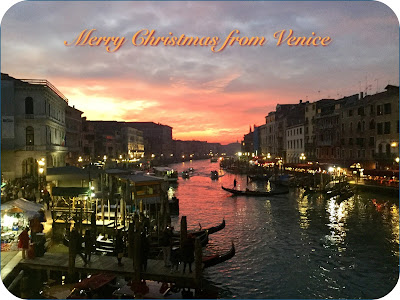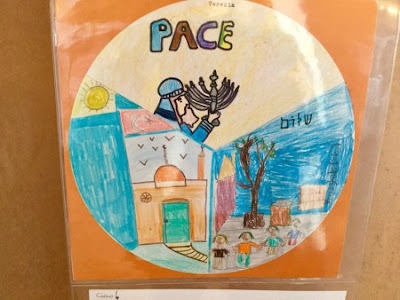 |
| Teatro Italia in its heyday |
Inaugurated on March 2, 1916 as a theater, Teatro Italia was the dream of the Venetian publisher, Giuseppe Scarabellin, along with the designer, Dominico Mocellin. The architect was Giovanni Sardi, renown for designing the Hotel Excelsior on the Lido.
Scarabellin had a vision of how he wanted the building to look, and hired the prominent artists Guido Marussig, Alessandro Pomi, Umberto Martina and Umberto Bellotto, who were all friends, to decorate the interior with their considerable talents, including Pomi's fresco The Allegory of the Glory of Italy in the center of the ceiling, and Bellotto's wrought iron enhancements.
Decades later, Teatro Italia morphed from a cinema into a lecture hall for Ca' Foscari, Venice's university, and then closed in the late 1990s, when it slid into decay and became a home for rats. If it hadn't been bought by Piero Coin and restored, it would have crumbled down.
 |
| Teatro Italia before the restoration |
The Most Beautiful Supermarket in the World? Teatro Italia Morphs into De Spar in Venice
That post caused all sorts of uproar, including opinionated, negative comments on social media by self-proclaimed Venice "experts," who were not Venetian, did not live in Venice and had never seen the interior of Teatro Italia -- nor had they ever visited the Despar supermarket. This was yet another example of outside forces and operatives trying to control the narrative here in Venice.
(Update 2024: Regrettably, I must again address this situation, which (astonishingly!) still continues all these years later.
One person in particular named JoAnn Locktov, an American and self-declared Jew (a topic featured in her tweets) who was based in California and is now based in Maine, and who self-publishes books called “Dream of Venice,” was outrageous. She copied and pasted — did not share — my post onto her Facebook profile. She changed the headline to “Teatro Italia Despar Morphs into Despair” and used my post to launch her own destructive narrative.
Later, I would discover that was not the only time she changed someone’s headline. I told her to knock it off. Instead of apologizing, she blocked me and went on a vicious smear campaign. In fact, she took a sacred Venetian event and tried to twist something beautiful into something dark. I have met liars before, but only one other who was that diabolical.
Locktov has since deleted her Facebook accounts, which were full of nasty personal attacks on many other people and organizations in Venice, not just me. But she still maintains accounts on X-Twitter, and is adept at using social media to try to manipulate the narrative about Venice. It is her daily obsession, and has been for for more than 15 years.I do not even know Locktov. She forced herself into my life, and the lives of other influencers in Venice, by manipulating social media. She has cyber-stalked and been blocked by many people, organizations, and companies in Venice, including Venetian officials. She interferes in local politics. Why?
She deliberately tries to foment friction in Venice, a town where she has never lived in her life, though she tries to create the impression on social media that she is based here. She has vendettas that go back more than a decade.She has stalked me since 2008. It could have been earlier, but that is the first I can document. That is 16 years ago! Locals in Venice have told me horrific lies she has spread about me. I have seen defamatory email with my own eyes. It is insanity.
I, and many others, have tried ignoring her, which causes her to escalate. She relentlessly tweets and retweets. She spreads false information, and then accuses others of not being truthful. I have been blocked on social media by accounts I have never interacted with. They are all connected to Locktov.Why she tried to smear Teatro Italia in the first place is beyond my comprehension—she was 6,000 miles away and had no personal knowledge of the supermarket. She behaves as if she is a US operative who has a serious mental illness. I hope she gets the help she seems to need.)
Now, back to Teatro Italia, which really is the most beautiful supermarket in the world.
I returned to Despar the next day, came home and wrote another post:
The Most Beautiful Supermarket in the World? Teatro Italia - Part Two: The Balcony
In January of this year, I attended a press conference presented by Despar, which provided details of the restoration. Executives from Despar were there, and as I have written previously, they are nice people who knew full well that they were taking on a difficult, historic project and made every effort to ensure their restoration was done with care down to the smallest details, and that the supermarket was of the highest quality.
Despar is proud of their recycling program, their bio products, that they are sustainable and that all their energy is green; they installed full LED lighting. The supermarket on Strada Nuova is a showcase for Despar Italia, and they have every incentive to keep the quality high.
 |
| Paul Klotz, President of Despar Italia "The Beauty of Sustainability" Photo: Cat Bauer |
De Spar was founded in 1932 by Adriaan van Well, a Dutch wholesaler who believed that independent wholesalers and retailers can achieve more by working together than working alone. In Dutch "De Spar" means "fir tree," which is their logo, and "Despar" is an an acronym of a slogan created by van Well to describe the organization: Door Eendrachtig Samenwerken Profiteren Allen Regelmatig, which translates into English as: All benefit from joint co-operation.
The group morphed into being simply SPAR ("spaar" means "save" in Dutch), except in Italy, where it is still Despar. Despar Italia is a consortium of six large companies of retailers, one of which is SPAR Austria Group (Aspiag), which is headquartered in Switzerland, and is the largest private employer in Austria.
 |
| Teatro Italia Orchestra in the balcony - Photo: Cat Bauer |
Well, the future is now. Back on September 8, 2017, I was invited to hear a concert by the newly-formed Teatro Italia Orchestra - TIO - a group of students from the Conservatorio Benedetto Marcello, Venice's school of music, founded and directed by Maestro Dario Bisso Sabadin. Imagine shopping for groceries when, suddenly, the music of violins and woodwinds fills the air.
Actually, you don't have to imagine. I filmed a short video, which you can watch below:
For those who want to educate themselves about Teatro Italia, a book about the history, restoration and repurposing of Venezia Cinema Teatro Italia was recently published in Italian by Marsilio. A limited edition will be published in English in February. I'll keep you posted.
UPDATE: An excerpt from the Foreword of the English edition, Bowing to Beauty:
CEO of Aspiag Service Srl
Ciao from Venezia,
Cat Bauer
Venetian Cat - The Venice Blog
Actually, you don't have to imagine. I filmed a short video, which you can watch below:
For those who want to educate themselves about Teatro Italia, a book about the history, restoration and repurposing of Venezia Cinema Teatro Italia was recently published in Italian by Marsilio. A limited edition will be published in English in February. I'll keep you posted.
UPDATE: An excerpt from the Foreword of the English edition, Bowing to Beauty:
---Paul KlotzI believe this is Cinema Teatro Italia's mission: to remind us that all products can be bought but beauty will always be a gift.
CEO of Aspiag Service Srl
Ciao from Venezia,
Cat Bauer
Venetian Cat - The Venice Blog






































